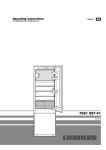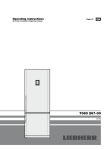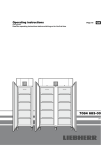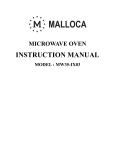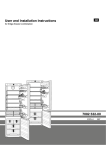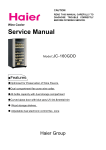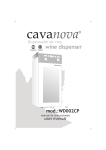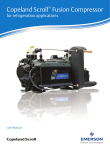Download Liebherr IKBV 3254 Premium
Transcript
Operating instructions for refrigerators for integrated use Page 10 GB 7081 243-01 IKBV 310 Disposal notes • Keep packaging materials away from children - polythene sheets and bags can cause suffocation! • Please return the packaging to an official collection point. Your old appliance: This contains some reusable materials and should be disposed of properly - not simply with unsorted household refuse. • Discarded appliances should be disabled: Remove the plug, cut through the connection cable and render the catch unusable so that children cannot become trapped inside. • Ensure that the refrigerant circuit is not damaged when the appliance that is no longer needed is taken away for disposal. • Details of the refrigerant can be found on the type plate. • Appliances which are no longer needed must be disposed of in a professional and appropriate way, in accordance with the current local regulations and laws. Range of appliance use The appliance is suited only for cooling food. In the case of commercial food cooling, the pertinent statutory regulations have to be observed. The appliance is not suited for storing and cooling pharmaceuticals, blood plasma, laboratory preparations or similar substances and products subject to the Medical Devices Directive 2007/47/EC. Any misuse of the appliance may result in damage to or spoilage of the stored goods. Furthermore, the appliance is unsuited for use in areas exposed to an explosion hazard. Description of appliance and equipment Operating elements Freezer compartment Refrigerator compartment Butter and cheese compartment Adjustable storage shelves Type plate Adjustable door rack Safety instructions and warnings • To prevent injury or damage to the unit, the appliance should be unpacked and set up by two people. • In the event that the appliance is damaged on delivery, contact the supplier immediately before connecting to the mains. • To guarantee safe operation, ensure that the appliance is set up and connected as described in these operating instructions. • Disconnect the appliance from the mains if any fault occurs. Pull out the plug, switch off or remove the fuse. • When disconnecting the appliance, pull on the plug, not on the cable. • Any repairs and work on the appliance should only be carried out by the customer service department, as unauthorised work could prove highly dangerous for the user. The same applies to changing the mains power cable. • Do not allow naked flames or ignition sources to enter the appliance. When transporting and cleaning the appliance ensure that the refrigerant circuit is not damaged. In the event of damage, make sure that there are no ignition sources nearby and keep the room well ventilated. • Do not stand on the plinth, drawers or doors or use them to support anything else. • This appliance is not intended for use by persons (including children) with reduced physical, sensory or mental capabilities or lack of experience and knowledge unless they have been given initial supervision or instruction concerning use of the appliance by a person responsible for their safety. Children should be supervised to ensure that they do not play with the appliance. • Avoid prolonged skin contact with cold surfaces or chilled/frozen food. This could cause pain, numbness and frostbite. In the case of prolonged skin contact, protective measures should be taken, e.g. gloves should be worn. • Do not eat ice cream, particulary ice lollies or ice cubes, immediately after taking them from the freezer compartment as there is a risk of "burning" because of the very cold temperatures. • Do not consume food which has been stored for too long, as it could cause food poisoning. • The appliance is designed for cooling, freezing and storage of food, and for making ice and is intended for domestic use. If used for commercial purposes, the relevant legal regulations applicable to the trade concerned must be observed. • Do not store explosives or sprays using combustible propellants such as butane, propane, pentane etc. in the appliance. Electrical components might cause leaking gas to ignite. You may identify such sprays by the printed contents or a flame symbol. • Do not use electrical appliances inside the appliance.• Do not connect the appliance to the supply with other equipment using an extension cable. This can cause the extension socket to overheat. • Special-purpose lamps (incandescent lamps, LEDs, fluorescent tubes) in the appliance serve to illuminate the appliance interior and are not suited for room illumination. Drawer for dry or wrapped food Climate rating Drawer with adjustable humidity Climate rating BioFresh The appliance is set to operate within specific ambient temperature limits according to its climate rating.These temperature limits should not be exceeded. The correct climate rating for your appliance is indicated on the type plate. SN N ST T Cellar temperature compartment Ambient temperature +10°C to +32°C +16°C to +32°C +16°C to +38°C +16°C to +43°C Remove all transit supports Unscrew the red transport lock. Close the vacated retaining hole using the plug. 10 Setting up • Standard EN 378 specifies that the room in which you install your appliance must have a volume of 1 m3 per 8 g of R 600a refrigerant used in the appliance, so as to avoid the formation of inflammable gas/air mixtures in the room where the appliance is located in the event of a leak in the refrigerant circuit. The quantity of refrigerant used in your appliance is indicated on the type plate on the inside of the appliance. Connecting to the mains Power supply (AC) and voltage at the operating point must comply with the details on the type plate, which is located inside the appliance on the left-hand side. The socket must be fused with a 10 A fuse or higher, it must be away from the rear of the appliance and must be easily accessible. Connect the appliance with a properly earthed fused plug and socket only. Saving energy - Always ensure good ventilation. Do not cover ventilation openings or grille. - Do not place appliance in areas of direct sunlight or next to a stove, heater or similar object. - The energy consumption depends on the installation conditions, e.g. the ambient temperature. - Keep the time the appliance is open to a minimum. - Store food logically. - Ensure that all food is well packed and covered for storage. This will prevent frost from forming. - First cool warm food to room temperature before storing it. - Defrost frozen food in the refrigerator. - If there is a thick layer of frost in the appliance: defrost the appliance. Setting the temperature GB The temperature of the refrigerator and cellar temperature compartment can be set separately. • To reduce the temperature: Press the DOWN button. • To increase the temperature: Press the UP button. - While you are setting the temperature, the temperature display will flash. - When you press the setting buttons for the first time, the set temperature will be displayed. - You can change the settings in increments of 1°C by briefly pressing the buttons again. - About 5 seconds after the button was last pressed the average interior temperature will be displayed. - The temperature can be set in the refrigerator compartment: between 9°C and 4°C and in the cellar temperature compartment: between 14°C and 4°C. • The temperature in the BioFresh compartment is controlled automatically, between 0°C and 3°C. The temperature in the BioFresh compartment can be changed if required. See "Additional functions" for more information. Temperature display The average temperature in the refrigerator compartment is displayed in normal mode. The display will flash if you change the temperature setting. If "F 0" to "F 5" appears in the display, the appliance has a fault. Consult the customer service department indicating the fault number displayed. Supercool Operating elements The SuperCool button switches the refrigerator/cellar temperature compartment to maximum cooling. This is recommended particulary if you wish to cool large quantities of fresh food as fast as possible. The refrigeration temperature drops to the level of the coldest temperature control setting. Switching on: Press the SuperCool button briefly so that the LED comes on. Refrigerator 7Temperature display 8Temperature buttons 9On/Off button blSuperCool button Cellar temperature compartment 1Temperature display 2Temperature buttons 3On/Off button 4SuperCool button 5Audible warning on/off button 6Child-proof lock Switching the appliance on and off Clean the interior of the appliance before switching it on for the first time (see "Cleaning"). To switch the appliance on: Note: The Supercool function uses more energy. After approx. 6 hours, however, the electronic system automatically switches back to normal energy-saving operation. Audible warning signal The audible warning signal helps you to protect the food in your refrigerator and save energy. - It will sound when the door has been open for longer than about 1 minute. • The signal will stop when you press the Alarm button or automatically when you close the door. Press the On/Off button 3. To switch the appliance off: Press the On/Off button 9 for approx. two seconds. To switch the cellar temperature compartment off: Press the On/Off button 3 for approx. two seconds. Note: If the refrigerator compartment (On/Off button 9) is switched off, the entire appliance will be switched off. 11 Additional functions In set-up mode you can set the childproof lock, adjust the brightness of the display and set the temperature in the BioFresh compartment slightly lower or higher. Activating set-up mode: • Press the SuperCool button 4 for approx. 5 seconds. - The SuperCool button flashes. - The display shows c for child-proof lock. Note: The value to be altered flashes. • Select the required function by pressing the Up/Down button 2: c = child-proof lock, h = display brightness or b = BioFresh temperature. • Now select/acknowledge the function by pressing the SuperCool button 4 briefly: >For c = child-proof lock, press the Up/Down button 2 to select c1 = child-proof lock on or c0 = child-proof lock off and acknowledge with the SuperCool button 4. When the symbol is lit, the child-proof lock is activated. >For h = brightness, press the Up/Down button 2 to select h1 = minimum to h5 = maximum brightness and acknowledge with the SuperCool button 4. >For b = BioFresh temperature, press the Up/Down button 2 to select from b1 = lowest to b9 = highest setting and acknowledge with the SuperCool button 4.The altered BioFresh temperature adjusts slowly to the new value. Note: b5 = factory setting. By decreasing the temperature, b4 to b1, minus temperatures can be reached and the food in the BioFresh compartment will freeze slightly. Exiting set-up mode: • Exit the set-up mode by pressing the On/Off button 3; after 2 min. the electronic system switches over automatically.The normal operating mode is activated again. Cooling Storage example 1butter, cheese, eggs 2cans, tubes 3bottles 4frozen food, ice cubes 5meat, sausage products, dairy products BioFresh compartment: 6meat, sausage products, fish, dairy products 7salad, fruit, vegetables Cellar temperature compartment: 8salad, fruit, vegetables, drinks Note • Food which gives off or absorbs odours and flavours as well as liquids should always be stored covered or in closed containers. High- percentage alcohols should be tightly sealed and stored upright. • Fruit, vegetables and salad can be stored unpacked in the bins. • Reuseable plastic, metal, aluminium and glass containers can be used for packaging. Pull-out compartment with cellar temperatures Suitable for storing cold-sensitive vegetables, tropical fruit and any food or drink you do not wish to consume too cold. 5Bottle container 6Container for vegetables and tropical fruits 7Container for small fruits and vegetables For cleaning, remove the container 5 by simply lifting it. To remove the container 6, pull it out completely, lift it at the back and pull it out towards you. Container 7 is fastened with screws. To insert container 6: - Extend the pull-out rails as far as they will go. - Place the container on the rails and slide it in. Adjusting appliance door • Slacken screws 1 right and left. • Adjust door angle with setscrew 2 and height with setscrew 3. • Fasten appliance door with screws 1. 12 BioFresh compartment The BioFresh compartment enables you to keep a range of fresh food fresh for up to 3 times longer than usual whilst maintaining the same quality as with conventional refrigerators. The automatically controlled storage temperature, which is kept constantly at just above 0°C, and the resultant humidity provide the ideal storage conditions for different types of food. The top drawer is suitable for storing dry or wrapped food (e.g. dairy products, meat, fish, cold meats). The storage climate in this drawer is relatively dry. The drawer with humidity control When set to "humid" this drawer can be used for storing salad, vegetables and fruit. When the drawer is full, the climate will be "dew-fresh", with approximately 90% humidity. You can set the humidity in this drawer to dry or moist as required. Humidity selection: • "dry" setting: small humidity symbol - slide control to left. Insert food that is suitable for being stored in a dry climate. • "humid" setting: high relative humidity of max. 90%, large humidity symbol - slide control to right. This setting is suitable for storing unwrapped food with a high moisture content such as fresh lettuce. Notes • The humidity in the compartment depends on the moisture content of the food in it, and the frequency with which the compartment is opened. • The fresher the product and the higher its quality, the longer it will keep. • Unwrapped animal and vegetable foods should be stored separately in the drawers. If there is not enough space for them to be stored separately, make sure that they are wrapped. Do not allow different types of meat to come into contact with one another but keep them packaged separately so as to avoid premature bacterial spoilage. • The following products should not be stored in the Biofresh compartment: hard cheese, potatoes, cold-sensitive vegetables such as cucumber, peppers, aubergines, avocados, semi-ripe tomatoes, beans, zucchini, and all cold-sensitive tropical fruits such as pineapple, bananas, grapefruit, melons, mangoes, papaya, etc. Freezer compartment GB You can store frozen food for several months, make ice cubes and freeze fresh food in the freezer compartment at a temperature of -18 °C and lower. The air temperature in the compartment, measured by thermometer or other instruments, may fluctuate. Freezing Fresh food should be frozen to core as quickly as possible. You can freeze up to 2 kg/24 hours. • Set the temperature to 5°C or lower. • Wait 24 hours. • Place the fresh food in the freezer. • After approx. 24 hours the fresh food will be frozen. • Now set the temperature to the normal setting. Deep frozen food can be placed into the cold freezer compartment straight away. Notes on freezing and storage • Pack frozen food in standard freezer bags or reuseable plastic, metal or aluminium containers. • Always write the date and contents on the pack and do not exeed the stated storage time for the food. • Do not freeze bottles and cans which contain carbonated drinks as they might burst. • Only take out as much food as is immediately required for thawing. Use food which has been thawed in prepared meals as quickly as possible. Frozen food can be thawed in the following ways: –in a fan oven –in a microwave oven –at room temperature –in the refrigerator: the cold given off by the frozen food is used for cooling. Making ice cubes • Fill the ice-cube tray with water. • Place the ice-cube tray in the appliance and leave it to freeze. • The ice cubes can be removed from the tray by twisting or by holding upside down for a short time under running water. 13 Equipment Defrosting You can re-arrange the storage shelves as required. Refrigerator compartment The refrigerator compartment defrosts automatically.The water that forms on the rear wall drains into a reservoir at the back of the appliance and evaporates automatically through the compressor heat. Lift the glass shelf, align the recess over the support and replace the shelf in a higher or lower position. Freezer compartment After a long period of operation, a layer of frost or ice can build up inside the freezer compartment. This increases energy consumption.You should therefore defrost the freezer compartment regularly. Repositioning the door racks - Lift door rack vertically (1), lift out to the front and re-insert at a different height, following these steps in the reverse order (2). • Switch the appliance off to defrost. Pull out the mains plug or set the temperature control to "0". • Wrap the frozen food in paper or blankets and store in a cool place. • To speed up the defrosting process put a saucepan of hot but not boiling water in the compartment. • Leave the door of the appliance open while defrosting. After defrosting mop up the remaining water and clean the appliance. - By shifting the bottle holder F you can protect the bottles from falling over when opening or closing the door. The sectioned glass shelves can be moved to make space for tall containers. Place the shelf rails provided, fig. 1, on the supports on the left and right at the desired height. Insert the glass shelves 1 and 2 as shown in fig. 2. The glass shelf 2 with the raised edge must go at the back. If you need to make space for tall containers, simply slide the front half of the sectioned glass shelf carefully underneath the back half, fig. 2. Do not use any mechanical devices or other artificial aids for defrosting other than those recommended by the manufacturer. Cleaning Before cleaning always switch off the appliance. Disconnect from the mains or unscrew or switch off the fuse. Clean the inside, equipment parts and outer walls with lukewarm water and a little detergent. Do not use abrasive or acid cleaners or chemical solvents. Do not use steam cleaners because of the risk of injury and damage. • Ensure that no cleaning water penetrates into the electrical components or ventilation grille. • Dry all parts well with a cloth. • Do not damage or remove the type plate on the inside of the appliance. It is very important for servicing purposes. fig. 1 On the floor of the refrigerator compartment you can either use the integrated bottle shelf for additional bottles or the glass shelf to make additional shelf space. If you use the bottle shelf, you can keep the glass shelf underneath the bottle shelf to save space. Interior LED light The interior light switches off automatically after the door has been opened for approx. 15 minutes. If the interior light does not switch on when the door is opened briefly, but the temperature display is working, the light may be defective. Attention! To prevent injury or damage, always ask our customer service department to carry out any repairs and replace the LED interior light. Caution - class 1M laser radiation. When cover is removed, do not look directly at light through optical instruments. 14 fig. 2 • To clean the BioFresh drawers, pull the drawers right out, grip at back and lift out. - To insert: place drawers on the fully extended rails closest to the door handle side of the appliance - the rails must align with the front of the drawer - and slide in. Malfunctions You may be able to rectify the following faults by checking the possible causes yourself: Installation dimensions (mm) • Appliance does not function: –Is the appliance switched on? –Is the plug correctly fitted in the mains socket? –Is the socket fuse intact? • Loud running noise: –Is the appliance set up firmly on the floor? –Does the appliance cause nearby items of furniture or objects to vibrate? Please note that noises caused by the refrigerant circuit cannot be avoided. • The temperature is not low enough: –Is the temperature setting correct (see "Setting the temperature")? –Have excessive amounts of fresh food been placed in the appliance? – Does the separately installed thermometer show the correct reading? – Is the ventilation system working properly? – Is the appliance set up too close to a heat source? If none of the above causes apply and you cannot rectify the fault yourself, contact the nearest customer service department stating the type of appliance ➊, service number ➋ and appliance number ➌ as indicated on the type plate. The type plate is located in the refrigerator compartment on the left-hand side. Shutting your appliance down If your appliance is to be shut down for any length of time, switch it off and disconnect the plug or switch off or unscrew the fuse. Clean the appliance and leave the door open in order to prevent unpleasant smells. The appliance complies with the relevant safety regulations and EC Directives 2004/108/EC and 2006/95/EC. GB A = 560-570 B = 550 C = 557 Max. weight of unit door Refrigerator compartment = 18 kg Cellar temperature compartment = 12 kg Changing the compartment door • At hinge 1 fold away the cover. Unscrew hinge 1 and remove the compartment door with the hinge. • Unscrew the closure 2. • Close the holes with the plugs 3. • Rotate the door and closure by 180° and replace on the other side: Insert the compartment door at the top, put the hinge 1 in place at the bottom, screw down again and close the cover. All types and models are subject to continuous improvement and the manufacturer therefore reserves the right to make modifications to the shape, equipment and technology. Stick sealing strip onto the side of the appliance on the handle side flush with the front: remove the protective film and stick on; shorten to recess height if necessary. 15 Changing over door hinges 1.Unscrew the ball stud. 2.Open the door. 3.Detach the soft stop mechanism. Installing in a kitchen unit • For 16 mm unit wall (568 mm recess): - Clip spacers bl onto the hinges. • Fit the equaliser trim 9 in the recesses on the retainer. Lift off covers 3. Loosen attachment screws 1 on the appliance. Remove the door. Replace all attachment screws 1 on the other side and screw in a little way. 8. Unscrew door attachment screws 2 and transfer the hinges to the diagonally opposite corner. 9. Suspend the appliance door on the screws 1inserted previously and tighten the screws. 10.Cover all open attachment holes with covers 3. 4. 5. 6. 7. • Remove cover bm. • Screw on the attachment brackets bn top and bottom. • Clip the stop brackets bo onto the attachment brackets top and bottom. 11.Re-attach the soft stop mechanism. 12.Close the door. 13.Screw the ball stud into the new fastening hole. 16 • Screw the attachment bracket bp into the predrilled holes on the appliance door using the hexagonal screw. Fitting a unit door GB 1.Lift the fitting aids out to the top, turn round and insert into the adjacent openings. • Slide appliance into the recess until the spacers make contact with the kitchen unit side panels. • Use the adjustig feet to align the appliance to an upright position, using the spanner supplied. 2.Slide the fitting aids 4 up level with the unit door: underside of stop edge of fitting aid = upper edge of unit door. 3.U n s c rew t h e c o u n t e r nuts 3. 4.Suspend the attachment strut 1 on the unit door. Fasten the appliance in the recess: • through the hinges at the side. Fasten the appliance in the recess: • through the top and bottom attachment brackets at the side. • Snap off and remove the front part of the stop bracket bo. This part will be needed for covering the top bracket in the next step. • Attach the top left covers. • Snap off and remove the front part of the bottom stop bracket.This part is no longer needed. • Click cover bq into place. 5.Fasten the attachment strut 1. 6.Lift the fitting aids 4 out to the top, turn round and insert into the adjacent openings. 7.Suspend the unit door on the door of the appliance/adjusting pins 2. Screw the counternuts 3 loosely onto the adjusting pins. 8.Align the unit door flush with the surrounding unit fronts: align laterally X by sliding in the corresponding direction, adjust height Y and lateral tilt with the adjusting pins 2 with a screwdriver. Tighten counternuts 3. 9.Adjust the depth of the unit door Z: loosen the screws 7. 10.Screw the appliance door onto the unit door through the attachment brackets. 11.Attach all the covers bq, br, bs. 17









